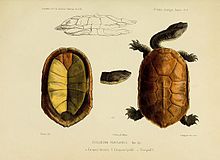Brazilian snake-necked turtle
| Brazilian snake-necked turtle | |
|---|---|

| |
| Scientific classification | |
| Domain: | Eukaryota |
| Kingdom: | Animalia |
| Phylum: | Chordata |
| Class: | Reptilia |
| Order: | Testudines |
| Suborder: | Pleurodira |
| Family: | Chelidae |
| Genus: | Hydromedusa |
| Species: | H. maximiliani
|
| Binomial name | |
| Hydromedusa maximiliani | |
| Synonyms[2] | |
| |
The Brazilian snake-necked turtle (Hydromedusa maximiliani ), locally known as cágado da serra, and also commonly known as Maximilian's snake-necked turtle, is a species of turtle in the family Chelidae. The species is endemic to southeastern Brazil.[3] It is one of the smallest Brazilian freshwater turtles reaching a maximum straight carapace length of 20 cm (7.9 in). The species prefers streams with sandy and rocky bottoms and clear water in forests above 600 m (2,000 ft) elevation.[3]
Etymology
[edit]The specific name, maximiliani, is in honor of German naturalist Prince Maximilian of Wied-Neuwied.[4]
Taxonomy
[edit]First described as Emys maximiliani by Mikan (1825),[1] it was subsequently moved to the genus Hydromedusa by Wagler (1830).[5] Several other species described later have since been synonymized with this species.[3] There are no recognised subspecies.[3]
Description
[edit]The Brazilian snake-necked turtle is a small species reaching a straight carapace length of between 10–20 cm (3.9–7.9 in) with a weight of 120–520 g (4.2–18.3 oz).[3] The carapace of the adult is oval in shape varying in color from dark gray, through to dark or light brown.[3] The plastron is a yellow or cream color. The species has a moderate-sized head with a small snout and yellowish jaws, with no barbels on the chin. The iris is black.[3] The dorsal surface of the head, neck and limbs are olive green to gray in color with a lighter cream-colored ventral surface.[3]
Distribution and habitat
[edit]The Brazilian snake-necked turtle is endemic to southeastern Brazil, in the states of Bahia, Minas Gerais, Espírito Santo, Rio de Janeiro and São Paulo.[3] The distribution is associated with the mountainous Atlantic rainforest. As a generalization it is found in mountain streams above 600 m (2,000 ft).[6]
The species is found in shallow streams from 15 to 100 cm (6–39 in) in depth, with clear, cold water and sandy or rocky substrates.[7] Because of the dense canopy and closed understory of the forests the streams receive little sunlight making basking only possible in gaps along the stream.[8]
Conservation
[edit]Some populations of this species, H. maximiliani, occur within protected areas and are hence afforded some protection from deforestation and pollution which are considered major threats.[3] In regions outside these protected areas the species may be becoming fragmented and may therefore become increasingly vulnerable in the future.[3]
References
[edit]- ^ a b Mikan JC (1825). Delectus Florae et Faunae Brasiliensis. Fasciculus Quartus. Vienna: A. Strauss. 6 pp., 6 plates. (Emys maximiliani, new species, p. 1). (in Latin).
- ^ Rhodin AGJ, van Dijk PP, Iverson JB, Shaffer HB, Bour R (2011). Turtles of the world Archived 2012-01-31 at the Wayback Machine, 2011 update: Annotated checklist of taxonomy, synonymy, distribution and conservation status. Chelonian Research Monographs 5.
- ^ a b c d e f g h i j k Souza FL, Martins FI (2009). Hydromedusa maximiliani (Mikan, 1825) - Maximilian's Snake-Necked Turtle, Brazilian Snake-Necked Turtle. Chelonian Research Monographs 5 (26): 1-6.
- ^ Beolens, Bo; Watkins, Michael; Grayson, Michael (2011). The Eponym Dictionary of Reptiles. Baltimore: Johns Hopkins University Press. xiii + 296 pp. ISBN 978-1-4214-0135-5. (Hydromedusa maximiliani, p. 171).
- ^ Wagler JG (1830). Natürliches System der Amphibien, mit vorangehender Classification der Säugthiere und Vögel. Munich, Stuttgart and Tübingen: J.G. Cotta. vi + 354 pp. + one plate. (in German and Latin).
- ^ Iverson JB (1992). A revised checklist with distribution maps of the turtles of the world. Richmond, Indiana: Privately Printed.
- ^ Souza FL (1995). "História natural do cágado Hydromedusa maximiliani (Mikan, 1820) no Parque Estadual de Carlos Botelho, SP, região de Mata Atlântica (Reptilia, Testudines, Chelidae)". Masters Thesis, Universidade Estadual Paulista, Rio Claro, SP, Brazil. (in Portuguese).
- ^ Yamashita C (1990). "Hydromedusa maximiliani ecology". Herpetological Review 21: 19.
"Hydromedusa maximiliani".IUCN Red List of Threatened Species.1996

